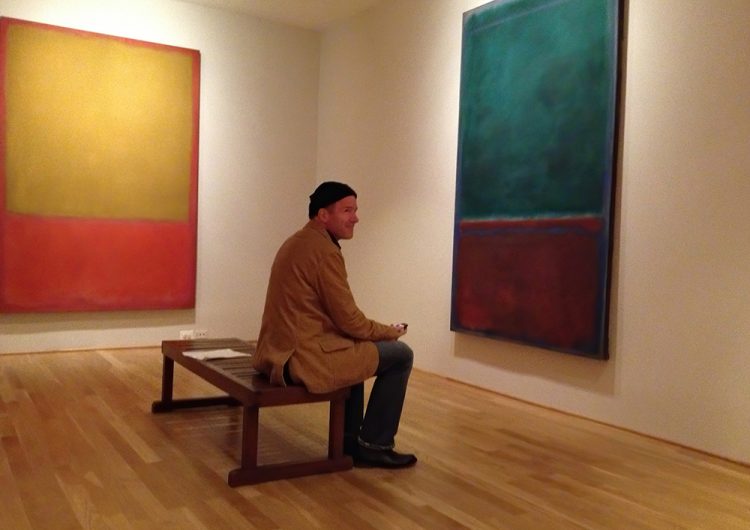The Phillips Collection galleries have been dark and empty and our staff and visitors have been missing our beloved collection. In this series we will highlight artworks that the Phillips staff have really been missing lately. Chief Curator and Deputy Director for Academic Affairs Klaus Ottmann on why he misses the Rothko Room.

Rick Moody recording the sound of the Rothko Room, The Phillips Collection, November 2, 2012. Photo: Klaus Ottmann
It is in during these difficult times when most of us find ourselves stranded at home that the superb stillness of the Phillips’s Rothko Room comes to my mind most frequently. Closed to the public since March 14, it has become a “stillpoint of the turning word” of which T.S. Eliot wrote in his poem Burnt Norton, where there is “neither from nor towards . . . where past and future are gathered. Neither movement from nor towards.”
Mark Rothko once told Katherine Kuh, a curator at the Art Institute of Chicago: “Since my pictures are large, colorful, and unframed, and since museum walls are usually immense and formidable, there is the danger that the pictures relate themselves as decorative areas to the walls. This would be a distortion of their meaning, since the pictures are the opposite of what is decorative; . . . By saturating the room with the feeling of the work, the walls are defeated.”
No space I know has been more saturated by the emotive potence of color than the Rothko Room. Rothko instructed his largest canvases to be installed “so that they must be first encountered at close quarters, so that the first experience is to be within the picture.” He intended his pictures to be “very intimate and human.” The intimate scale of the Rothko Room epitomizes the artist’s desire to have the viewer enter into the human dramas acted out in his paintings:
“I think of my pictures as dramas, the shapes in the pictures are the performers. They have been created from the need for a group of actors who are able to move dramatically without embarrassment and execute gestures without shame.”
In his Duncan Phillips Lecture, delivered on November 2, 2012, on the heels of another apocalyptic disaster, Hurricane Sandy, novelist Rick Moody recalled the time, when, as a college student in the 1970s, he experienced a performance of John Cage’s “silent” piano work 4′: 33”. He compared the experience to going through psychiatrist Elizabeth Kübler-Ross’s five stages of grief: denial, bargaining, anger, depression, and acceptance. He ended his lecture with an appeal to “listen” to visual art by playing the “sound” of the Rothko Room he had recorded earlier with his iPhone.
In The Birth of Tragedy, Nietzsche wrote:
“There is a need for a whole world of torment in order for the individual to produce the redemptive vision and to sit quietly in his rocking chair in mid-sea, absorbed in contemplation.”

Thank you for this reflection, particularly the connections to drama and music, lifting up the symbiotic relationships of different art forms and aspects of the human condition. I have a reflection on The Rothko Room I’d like to send to staff. Would you let me know where I could send it?
Dear Mr. Ottmann,
Your director sent a mailing “In Support of #BlackLivesMatter”.
Anyone can send a ridiculous virtue-signaling message dripping with wokeness.
I suggested it would be a meaningful and powerful statement to sell one of those Rothko’s and donate the entire proceeds to BLM and other social justice organizations.
This would really show how much the Phillips cares and supports equality and as I have always said, leading by example is the best example.
They can replace the empty wall with a “BLACK LIVES MATTER” banner and rename the space the Rothko Room for Justice and Equality.
I reccomend the green and maroon painting that Mr. Moody is facing in the accompanying photo. Surly that one would fetch a king’s ransom at Christie’s “post war” fall auction.
I can picture in my mind’s eye the hanging banner that will replace it…